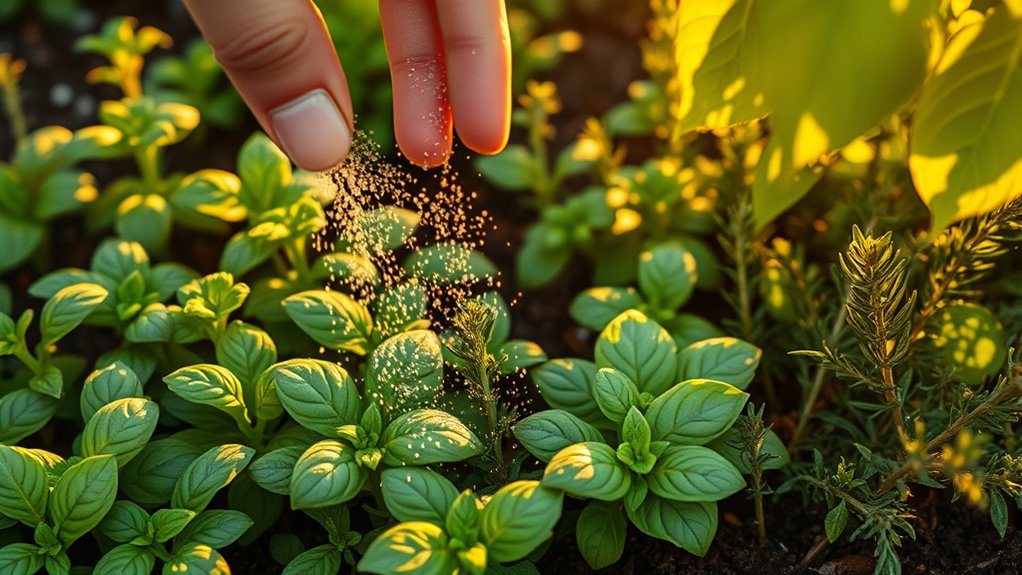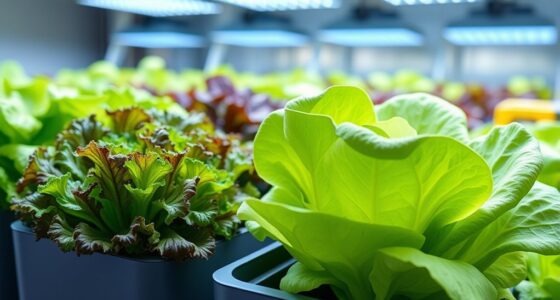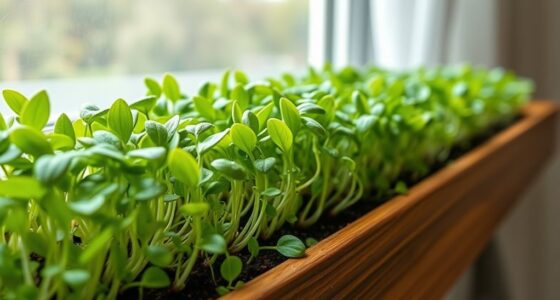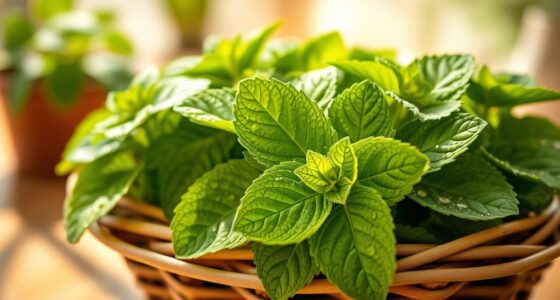To boost your herbs’ flavor, fertilize during active growth phases like early spring and when new leaves appear. Use organic options like compost or fish emulsion for better taste and soil health, or choose balanced, water-soluble synthetic fertilizers if needed. Apply gently around the base, follow recommended doses, and avoid overfeeding, especially before flowering. Maintaining proper soil pH and adjusting for container or garden setups helps maximize aroma—discover more tips ahead.
Key Takeaways
- Fertilize herbs during active growth phases, such as early spring and when new leaves emerge, to enhance flavor development.
- Use balanced organic fertilizers like compost or fish emulsion weekly, adjusting frequency based on plant response.
- Avoid fertilizing during flowering or dormancy to prevent flavor dilution and promote healthy flowering.
- Tailor fertilization to soil pH (6.0-7.0) for optimal nutrient absorption, boosting herb aroma and taste.
- Monitor plant health regularly, reducing or adjusting feeding if signs of deficiency or overfeeding appear.
Understanding the Nutritional Needs of Different Herbs

To guarantee your herbs develop vibrant flavors, it’s vital to understand their specific nutritional needs. Each herb has unique nutrient requirements, so knowing what they need ensures healthy growth and rich taste. For example, basil thrives with nitrogen, while rosemary prefers less nitrogen but more potassium. Soil pH management is equally important; most herbs prefer a slightly acidic to neutral pH (6.0-7.0). If the soil is too acidic or alkaline, nutrient absorption drops, affecting flavor and growth. Regularly test your soil to maintain proper pH levels, and adjust with lime or sulfur as needed. Providing the right balance of nutrients and maintaining ideal soil pH creates an environment where herbs can develop their full flavor potential. Understanding these factors helps you produce herbs that are both healthy and flavorful. Additionally, paying attention to plant health monitoring can help identify deficiencies early, ensuring optimal flavor development.
Recognizing the Best Time to Fertilize During Growth Cycles
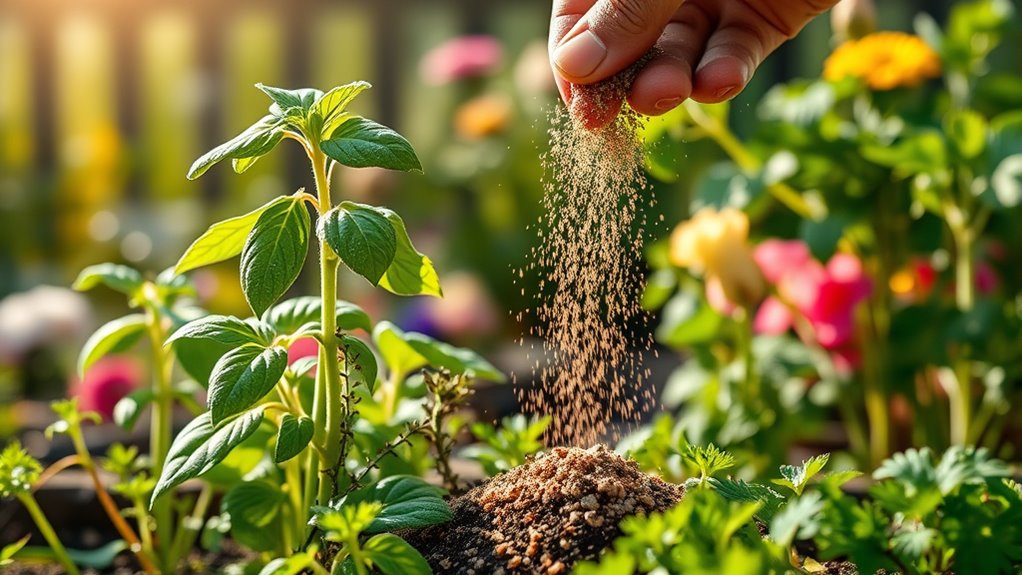
Timing your fertilization correctly is essential to guarantee your herbs grow strong and develop ideal flavor. The best time to fertilize depends on your herb’s growth stage and soil pH. Generally, fertilize during active growth, such as early spring or when new leaves appear, to maximize flavor without overfeeding. Avoid fertilizing during dormancy or when plants are stressed. Monitoring soil pH helps guarantee nutrients are available; herbs prefer slightly acidic to neutral soil. To visualize, consider this:
| Growth Stage | Fertilizer Timing |
|---|---|
| Early growth | Begin fertilizing to promote growth |
| Mid-growth | Continue light feeding |
| Pre-flowering | Reduce or pause fertilization |
Adjust based on your herb’s response, ensuring you don’t disrupt nutrient balance. Being attentive to the growth cycle of herbs can help optimize flavor development and overall health.
Choosing the Right Type of Fertilizer for Flavor Enhancement
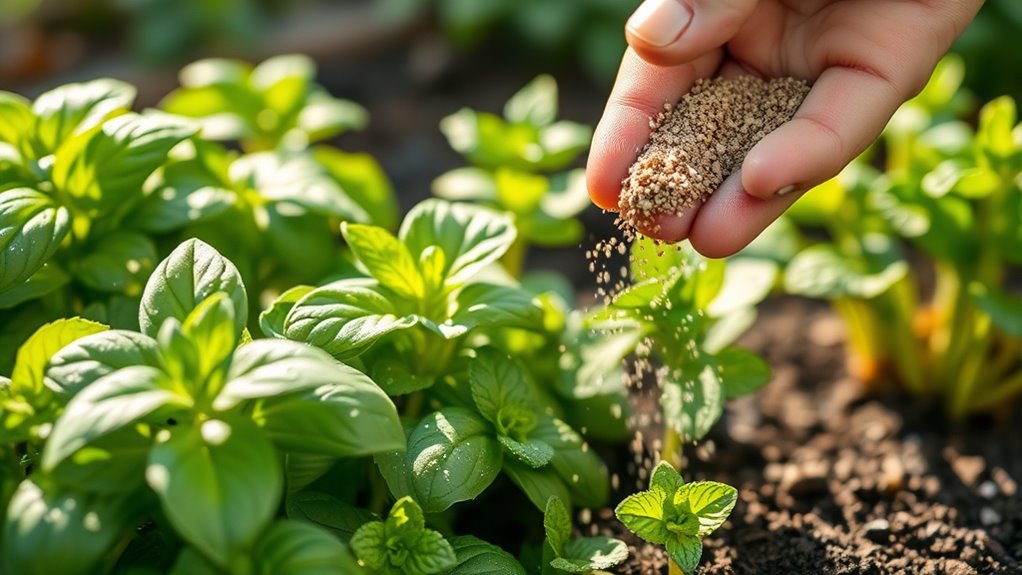
When selecting a fertilizer, you need to consider whether organic or synthetic options best suit your herbs. Each type provides different nutrients that can influence the herb’s flavor, so understanding their benefits helps you make the right choice. Focusing on nutrients that enhance taste ensures your herbs develop the rich flavors you’re aiming for. Additionally, choosing the right fertilizer can support the father-daughter bond, emphasizing the importance of nurturing growth and development.
Organic vs. Synthetic Options
Choosing the right fertilizer for your herbs can substantially influence their flavor, and deciding between organic and synthetic options is an important step. Organic fertilizers, like compost or fish emulsion, promote healthy soil and support pest prevention naturally, leading to more robust herbs. They also improve watering practices by enhancing soil moisture retention, which helps prevent overwatering or drought stress that can dull flavor. Synthetic fertilizers provide quick nutrient boosts but may require more careful watering practices to avoid salt buildup, which can harm plants and reduce taste quality. While organic options tend to encourage a healthier environment and better pest prevention, synthetic ones offer convenience and rapid results. Your choice depends on your gardening goals, but balancing pest management with proper watering practices ensures herbs develop their full flavor potential.
Nutrients for Taste Boost
To enhance the flavor of your herbs, selecting the right nutrients is essential. Start by conducting soil testing to determine nutrient levels and pH balance, making sure you supply what your herbs need without over-fertilizing. A balanced fertilizer rich in nitrogen promotes lush, flavorful foliage, while phosphorus supports root development and overall health. Incorporate organic options, like compost or fish emulsion, for natural nutrient boosts. Proper fertilization also aids pest prevention, as healthy plants resist pests better. Avoid excessive fertilizing, which can lead to weak growth and diminished taste. Remember, understanding your soil’s needs helps you choose the most effective fertilizer, maximizing flavor without compromising plant health. Tailoring nutrients based on soil testing ensures your herbs develop rich, vibrant flavors naturally. Additionally, being aware of professional help can provide tailored advice for your specific soil and plant conditions.
Organic vs. Synthetic Fertilizers: Pros and Cons for Herbs
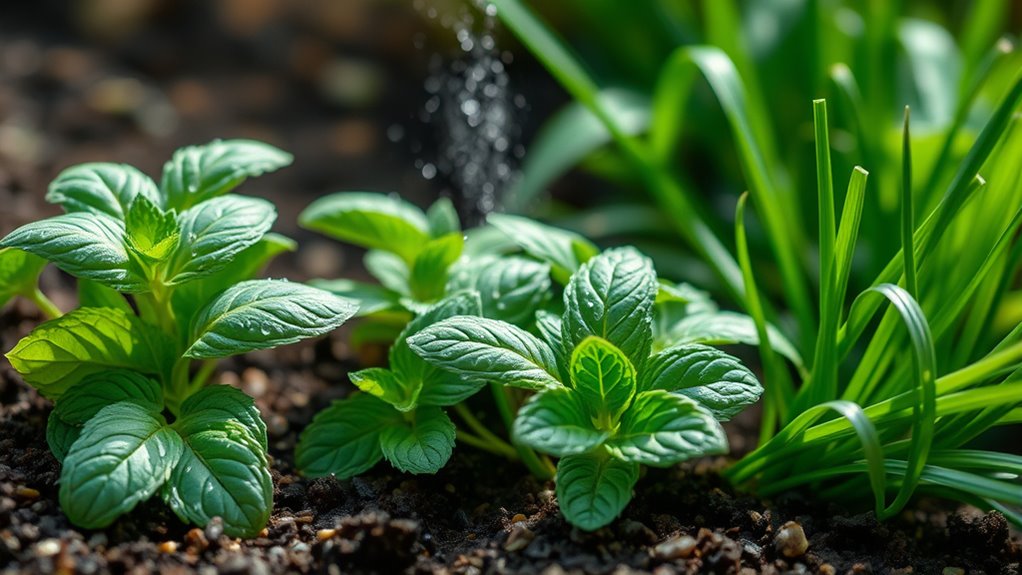
Organic and synthetic fertilizers each have distinct advantages and drawbacks when it comes to nourishing your herbs. Organic options improve soil pH naturally over time and enhance soil structure, promoting healthier roots. They also support pest control by encouraging beneficial insects and microbes that help keep pests at bay. Additionally, organic fertilizers often release nutrients slowly, which can delay visible growth and flavor development. Synthetic fertilizers provide quick nutrient boosts, making them ideal for fast results, but they can disrupt soil pH balance if overused and may weaken natural pest resistance. Furthermore, synthetic options lack the microbial benefits organic fertilizers offer. Choosing between them depends on your garden’s needs, but balancing both can optimize herb health, flavor, and overall soil essential. Incorporating preppy dog names can add a touch of style and sophistication to your gardening experience.
How to Apply Fertilizer for Optimal Absorption and Flavor
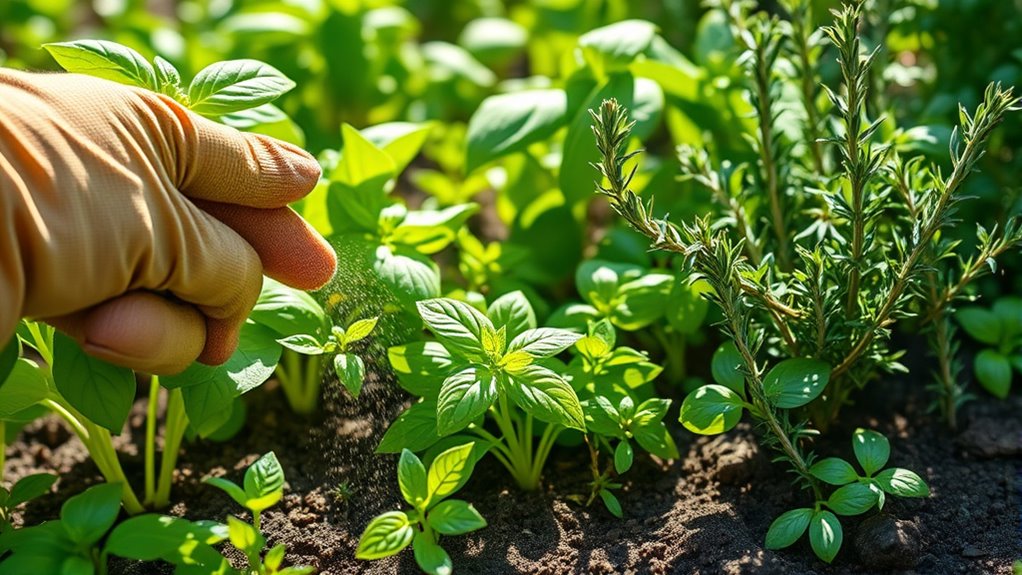
Proper fertilizer application is key to ensuring your herbs absorb nutrients effectively and develop rich, flavorful leaves. To achieve this, start by checking your soil pH; herbs generally prefer a slightly acidic to neutral pH (6.0-7.0), which maximizes nutrient availability. Adjust the soil pH if necessary to promote ideal root health, as healthy roots are essential for nutrient uptake. When applying fertilizer, follow the recommended dosage and timing, avoiding over-fertilization that can harm roots or cause nutrient runoff. Incorporate the fertilizer into the soil gently around the base of the plants, ensuring direct contact with the roots. Consistent, well-timed applications, combined with proper soil pH management, will boost your herbs’ ability to absorb nutrients and develop maximum flavor.
Signs That Your Herbs Need a Fertilizer Boost
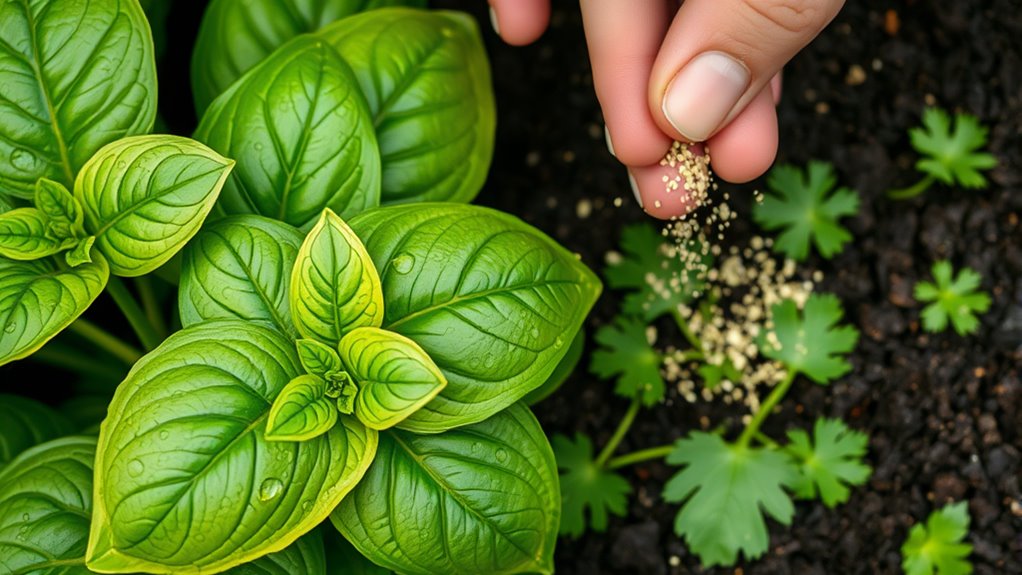
Healthy herbs display vibrant foliage and vigorous growth, but when they start to look dull or sluggish despite good soil conditions, it may be a sign they need a fertilizer boost. One clue is if their soil pH isn’t ideal, limiting nutrient uptake. Pale leaves or weak stems can also indicate nutrient deficiencies that fertilization can fix. Additionally, if pests become a problem despite good pest control practices, it might be because your herbs aren’t healthy enough to resist invaders. Observe your plants closely; poor growth, yellowing leaves, or slow new shoots signal they need extra nutrients. Addressing soil pH and providing targeted fertilization can revitalize your herbs, helping them thrive and develop maximum flavor.
Frequency of Fertilization for Continuous Flavor Development

To keep your herbs flavorful, you need a regular fertilization schedule that fits their growth cycle. Remember to adjust your feeding based on the seasons, as their needs change throughout the year. Keep an eye on how your plants respond, so you can fine-tune your fertilization frequency for continuous flavor development.
Regular Feeding Schedule
Establishing a regular fertilization schedule is essential for maintaining herbs with vibrant flavor. You should feed your herbs consistently, about once a week, to support steady growth and taste development. Using compost tea is a great way to provide nutrients naturally and boost flavor, especially when applied during watering sessions. Incorporate foliar feeding with diluted liquid fertilizers to give your herbs a quick nutrient boost, especially during active growth periods. This method allows nutrients to be absorbed directly through the leaves, promoting lush foliage and intense flavors. Stick to a routine, adjusting frequency based on your herbs’ needs and growth stage. Regular maintenance and understanding the importance of proper toilet flushing can help you keep your gardening tools and environment clean, ensuring your herbs stay healthy, flavorful, and ready for harvest at any time.
Seasonal Fertilizer Adjustments
Adjusting your fertilization frequency with the seasons guarantees herbs develop continuous, vibrant flavor throughout the year. During spring and summer, increase fertilizing to support lush growth, but reduce it in fall and winter when herbs grow more slowly. This prevents overfeeding, which can weaken plants and attract pests, undermining pest prevention efforts. Consistent watering routines are essential to help herbs absorb nutrients effectively, especially when adjusting fertilizer levels. Proper watering also minimizes stress, reducing vulnerability to pests. In hot months, fertilize more frequently to sustain flavor development, while in cooler seasons, cut back to avoid nutrient buildup. Additionally, incorporating aquatic exercise techniques can improve overall plant health and resilience, indirectly supporting better flavor. By tailoring your fertilization schedule to seasonal changes, you encourage healthy, flavorful herbs that thrive year-round.
Monitoring Plant Response
Monitoring how your herbs respond to fertilization guarantees you provide just the right amount of nutrients for continuous flavor development. Check their growth regularly, observing for signs like vibrant leaves or stunted development. Keep soil pH in mind, as imbalances can hinder nutrient absorption and affect flavor. Use a soil test kit if needed to guarantee ideal pH levels. Stay alert for pest activity, since pests can stress plants and compromise flavor. If you notice pests or weak growth, adjust your fertilization schedule accordingly. Consistent monitoring helps prevent over-fertilizing, which can lead to nutrient buildup or pest problems, and ensures your herbs stay healthy and flavorful. Proper general ledger coding can also help track your gardening expenses effectively. By paying close attention, you maximize flavor without risking plant health.
Special Considerations for Container vs. Garden Herbs
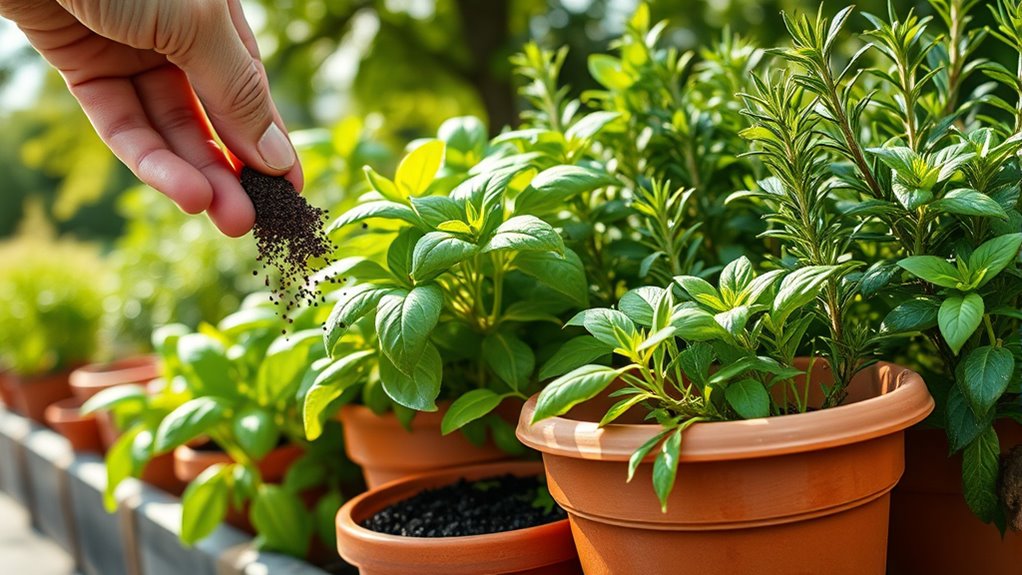
Growing herbs in containers requires different fertilizing strategies than planting them in the garden, primarily because containers have limited soil volume and nutrients. You need to monitor soil pH closely to guarantee ideal nutrient uptake, as pH imbalances can affect flavor development. Additionally, container herbs are more prone to pests, so regular pest prevention is essential. Consider these points:
- Use balanced, water-soluble fertilizers to prevent over-fertilization, which can harm flavor.
- Replenish nutrients more frequently due to quicker nutrient depletion in small soil volumes.
- Adjust fertilization based on soil pH and watch for pest issues that could weaken plants or alter taste.
- Incorporating tuning techniques such as precise nutrient management can optimize herb flavor and health.
Container herbs require attentive fertilization to maximize flavor without compromising plant health.
Tips for Avoiding Over-Fertilization and Flavor Deterioration
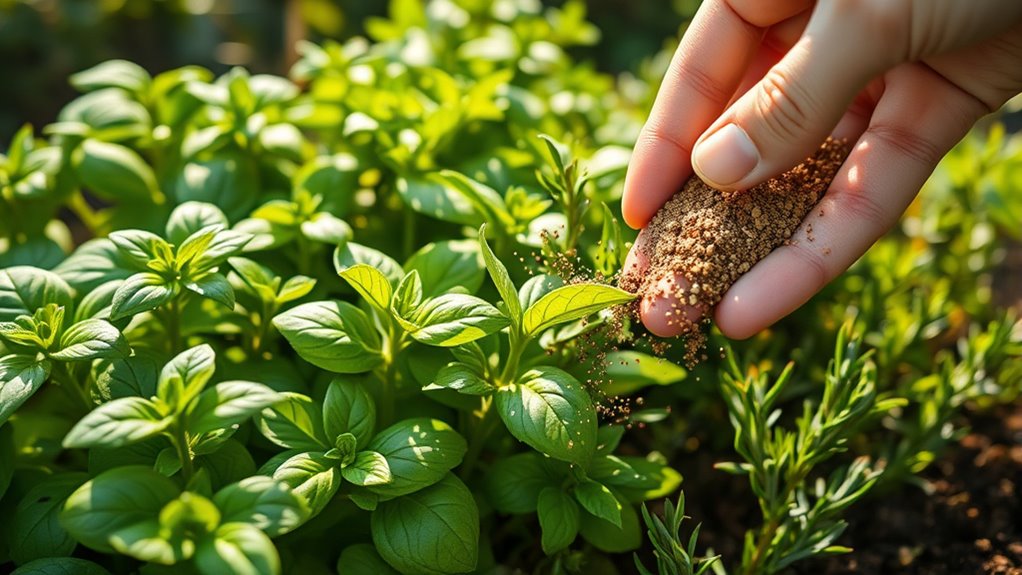
To prevent over-fertilizing your herbs and risking flavor loss, it’s important to apply fertilizers carefully and in moderation. Start by conducting soil testing to understand nutrient levels, preventing unnecessary excess. Over-fertilization can lead to lush foliage but dull flavor, so monitor plant health closely. Maintain pest control, as pests can weaken herbs and affect taste. Use this table to keep your fertilization balanced:
| Tip | Benefit |
|---|---|
| Test soil regularly | Prevents nutrient overload |
| Apply fertilizers sparingly | Enhances flavor, avoids bitterness |
| Observe plant response | Adjust feeding for ideal taste |
Additionally, choosing high-efficiency solar panels can help ensure your garden receives sustainable energy, supporting healthy herb growth without chemical fertilizers.
Seasonal Fertilization Strategies to Maximize Herb Aroma
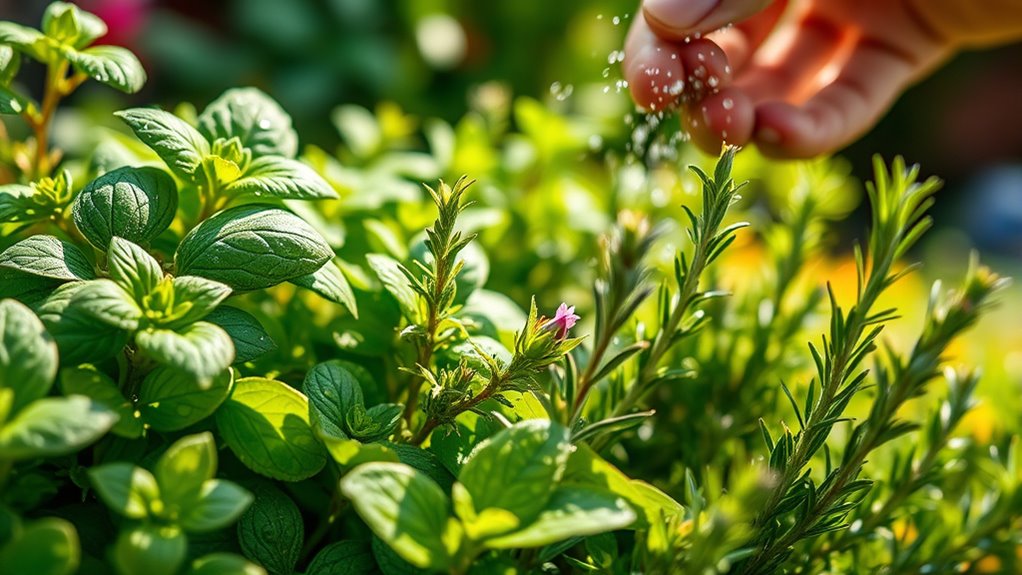
Adjusting your fertilization practices throughout the year can considerably boost your herbs’ aroma and flavor. Seasonal fertilizer timing is key to enhancing herb aroma during peak growth periods.
To maximize flavor, consider these strategies:
- Spring: Use a balanced fertilizer early in the season to promote lush, aromatic growth.
- Summer: Reduce nitrogen to prevent overly leafy herbs and encourage concentrated herb aroma.
- Fall: Apply a slow-release or organic fertilizer to strengthen roots and preserve flavor for winter storage.
- Incorporating ethical hacking principles can help protect your garden’s digital infrastructure and ensure your gardening data remains secure.
Frequently Asked Questions
Can Fertilizing Herbs Affect Their Natural Aroma and Essential Oil Content?
Fertilizing herbs can impact their natural aroma and essential oil content if not done correctly. Over-fertilizing may dilute essential oil preservation and reduce aroma strength, while proper nutrient balance enhances aroma enhancement strategies. To maintain maximum flavor, you should use a gentle, balanced fertilizer and avoid overfeeding. This guarantees your herbs retain their essential oils and aromatic qualities, resulting in more flavorful, fragrant herbs in your kitchen.
Are There Specific Fertilizers That Enhance Herb Color and Appearance?
You can use fertilizers with specific additives to enhance herb pigmentation and improve their vibrant appearance. Look for products containing micronutrients like iron and manganese, which promote healthy coloration. These fertilizer additives support lush, colorful foliage and help your herbs look more appealing. Apply them according to your herb’s needs and growth cycle, ensuring you don’t over-fertilize, which can harm your plants and reduce their natural beauty.
How Does Soil Ph Influence Herb Flavor When Fertilizing?
Think of soil pH as the secret ingredient in a recipe—if it’s off, your herbs won’t taste as vibrant. Soil acidity and pH balance directly influence nutrient absorption, impacting flavor. If your soil is too acidic or alkaline, herbs may become bland or bitter. Keep soil pH between 6.0 and 7.0 for most herbs, ensuring they absorb essential nutrients and develop rich, delicious flavors.
Can Fertilization Practices Differ for Culinary Versus Medicinal Herbs?
You can definitely tailor fertilization practices for culinary versus medicinal herbs. For culinary herbs, you focus on organic amendments that enhance flavor, like compost or fish emulsion, and implement pest management to keep plants healthy. Medicinal herbs might need gentler feeding to preserve their medicinal compounds, using similar organic amendments but with less frequent fertilization. Adjusting these practices helps maximize each herb’s desired qualities without over-fertilizing or stressing the plants.
Is It Necessary to Flush Out Excess Fertilizer Before Harvesting Herbs?
Imagine your herbs as performers on stage—excess fertilizer buildup is like unwanted stage noise. You need to flush out this buildup before harvest to prevent runoff management issues and make certain of pure flavor. Watering thoroughly helps wash away any lingering nutrients, much like clearing the stage for a perfect performance. This step guarantees your herbs taste fresh and vibrant, free from the effects of excess fertilizer lingering after fertilization.
Conclusion
Remember, timing is everything when it comes to fertilizing your herbs. By understanding their needs and applying nutrients thoughtfully, you’ll boost their flavor and aroma. Don’t forget, “a little goes a long way,” so avoid overdoing it. With proper fertilization strategies tailored to your herbs’ growth stages and environment, you’ll enjoy vibrant, flavorful herbs all season long. Happy gardening and savor the delicious results!
